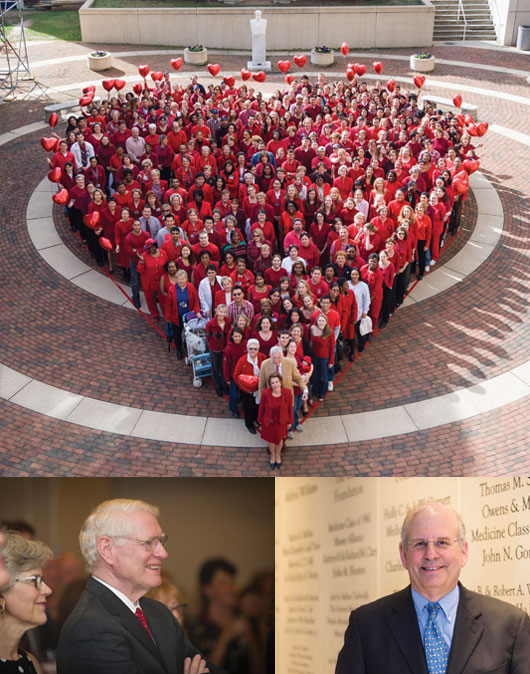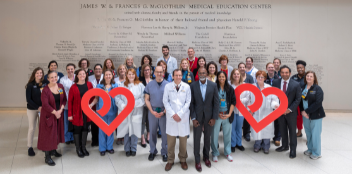A Spectacular Run

Meet John Duval, Dr. Jerry Strauss and Dr. John Ward—the VCU administrative dream team that has helped shape Pauley into a leading heart center.
For over a decade, the Pauley Heart Center has benefited from the teamwork and devotion of the senior leaders of the VCU Health System and VCU Medical Center.
CEO John Duval, MBA, FACHE, Medical School Dean Jerome F. “Jerry” Strauss III, M.D., Ph.D., and President of MCV Physicians John Ward, M.D., MSHA, have worked closely together and with heart center leaders to provide Pauley with the support and vision necessary to become a top-tier heart program.
With Duval’s retirement last September, and Strauss and Ward returning to research and medicine full-time this year, they will leave behind a legacy of excellence.
When John Duval began as CEO of VCU Hospitals and Clinics and vice president for Clinical Affairs in June 2004, he was impressed with the institution’s innovative cardiology and cardiac surgery programs. But one of his first goals was to rebuild the renowned heart transplant program that began at MCV in the 1960s.
 John Duval tours the ED with Will Wade.
John Duval tours the ED with Will Wade.
“Dr. Richard Lower developed the techniques for human heart transplantation right here on this campus,” says Duval, from his Marshall Street office, where he is working as a consultant until March. “We were one of the most active heart transplant centers nationally and internationally then, but we lost our focus in the ‘80s and ‘90s, and the program was impacted.”
Duval partnered with cardiothoracic surgeon Vigneshwar Kasirajan, M.D., to help rejuvenate the program. Kasirajan helped recruit others, and “we’ve grown from the five transplants that we did back in 2002 to 30 in 2016,” says Duval.
Additionally, the pair, along with Michael Hess, M.D., and George Vetrovec, M.D., were instrumental in bringing the total artificial heart program to VCU in 2006. “We’ve done 100 now, and are now among the largest programs in the world for the total artificial heart,” says Duval. When combined with the explosive growth of the heart failure and mechanical assist device programs, he says, “it’s just been a spectacular run.”
“John always had this notion that what sets this place apart, and what made this place great in terms of cardiovascular science, was the development of heart transplantation here by Dr. Richard Lower decades ago,” said Chair of Cardiology and Kontos Professor Kenneth Ellenbogen, M.D. “John helped us put together what is once again a world class program in heart transplantation, as well as heart failure and mechanical assist devices.”
“We’ve done 100 now, and are now among the largest programs in the world for the total artificial heart,” says Duval.
Duval also pushed for the creation of the $184 million Critical Care Tower, which opened in 2008. The 15-story, 232-bed facility includes intensive care units for surgical trauma, neonatal, burn center, cardiac, neuroscience, medical respiratory and oncology patients and was designed from the ground up to meet the complex needs of critically ill patients, with larger rooms for multidisciplinary care and safety features such as single occupancy and negative pressure ventilation systems that prevent cross-contamination of airborne particles.
“Some were skeptical, at the time, of the tower. But today, I can’t imagine us not having it,” said Chair of Surgery Vigneshwar Kasirajan, M.D. “John always saw things beyond the horizon.”
Under Duval’s leadership, a hospital safety program began in 2008 that has resulted in over 16,000 team members receiving training in safe behaviors and error prevention. VCU has since experienced a 50% reduction in serious safety events, and in 2014 was awarded the American Hospital Association McKesson Quest for Quality Prize, the organization’s top honor for leadership in safety and quality improvement.
One of the highlights of his career at VCU has been “the dedication of the teams to becoming the safest health system in America,” he says. “The fact that patients are leaving our building today not knowing that they benefited from the infection they didn’t get, from the mishap they didn’t have, from the complication that didn’t occur. That excites me. And I think that’s what this journey is all about: We are reducing harm in the delivery system.”
“I could not be more proud of the accomplishments of my teammates.”
Jerry Strauss III, M.D., Ph.D., an internationally recognized researcher in obstetrics and gynecology, began his tenure as dean of the VCU School of Medicine and executive vice president for medical affairs for the VCU Health System in September 2005.
When Strauss arrived to VCU, “the major goal that was handed to me was to increase the quality and the quantity of the research at the institution,” he says, from his office on the 4th floor of the James W. and Frances T. McGlothlin Medical Education Center. “I certainly saw a lot of opportunities for the medical center to become a prominent leader in some core areas, and cardiovascular medicine, because of the rich history of the institution in that research and clinical care domain, really stood out as one of my top priorities.”
Strauss worked with Shelden Retchin, M.D., the former senior vice president for VCU Health Sciences, and then-Chair of Cardiology George Vetrovec, M.D., to begin a philanthropic campaign to build the resources to support the cardiovascular programs. “That’s how the Pauley Heart Center was created initially, with a $5 million gift from Stan and Dorothy Pauley.”
“I think the three of them working together has made a lot of things happen. The CEO of the hospital, the dean of the School of Medicine, and the head of the practice plan all being aligned has really allowed us to move clinical programs, quality, education and research forward.” — Vigneshwar Kasirajan, M.D.
The 2006 gift led to other significant donations from the philanthropic community to invest in program development “and endow positions that have allowed us to recruit a team of truly exceptional clinicians and researchers,” he says. The donors played a critical role. “We could not have done all this without them.”
Over the past decade, the research of the faculty—including both clinicians and basic scientists—has helped the institution grow in national and international prominence. Strauss points out many examples, including the work in cardiac resuscitation of emergency physician Joe Ornato, M.D., and cardiologist Mary Ann Peberdy, M.D., which recently helped attract the Weil Institute to VCU.
“Jerry had a vision of what he wanted the heart center to become, and he has worked tirelessly towards making it one of the top clinical and scientific centers in cardiovascular disease. He has been steadfast in his determination and devotion,” said Kenneth Ellenbogen, M.D.
 VCU Pauley Heart Center stands as a leader among its peers—A reputation made possible by the extraordinary teamwork of its physicians, nurses and other staff. / John Ward, M.D., and Jerry Strauss, M.D.
VCU Pauley Heart Center stands as a leader among its peers—A reputation made possible by the extraordinary teamwork of its physicians, nurses and other staff. / John Ward, M.D., and Jerry Strauss, M.D.
“From a Department of Surgery standpoint, he’s put a lot of effort into helping us to grow innovative programs and research. Over the last few years, he has given us academic funds for research, which we have used as seed money for new faculty to start some new projects,” said Vigneshwar Kasirajan, M.D.
In 2013, Strauss introduced a new medical school curriculum, which departed from the traditional path of two years of basic sciences followed by two years of clinical education. While still a four-year program, “we compressed the preclinical component into one year to get the students into the clinical arena as soon as possible, so that the basic science had meaning with respect to patient care,” he says.
Boosting the success of the new curriculum—and something that was not anticipated when Strauss began his position-—was the opening in 2013 of the 12-story medical education center, a stunning, modern building designed by I.M. Pei’s firm. The building was initiated with a $25 million gift from the McGlothlin family, and ultimately made possible with over $190 million in gifts and pledges. With two floors dedicated to simulation and learning clinical skills, “the James W. and Frances T. McGlothlin Medical Education Center is the embodiment of the new curriculum in a physical space,” he says.
All the investments are paying off. “Applications to medical school have more than doubled. When I came, there were about 4,200; now we’re close to 9,000,” says Strauss. “What’s happened over the past few years has been remarkable.”
Neurosurgeon and President of MCV Physicians John Ward, M.D., M.S.H.A., is having a busy morning, but makes time for an interview. He’s already made morning rounds and attended senior leadership and MCV Physicians committee meetings. More sessions will follow in the afternoon.
“We have about 700-720 physicians, and as president of the practice plan I represent those physicians, work closely with the chairs in terms of the faculty, and am responsible for the strategic direction of the practice plan,” he says. “It’s a real partnership between myself and the 19 department chairs.”
Since taking the reins in 2009, Ward, working with Strauss and Duval, has been involved with chair and physician recruiting efforts for the downtown campus, including the recruitment of six heart failure cardiologists. He also heads up recruiting for the affiliated specialty clinics. For the VCU Community Memorial Hospital in South Hill, for instance, he helped bring in 14 new physicians, including cardiologists.
“John Ward is the glue that holds the doctors together and makes sure the doctors in the medical center work together. He has also done an outstanding job of putting together a core of cardiovascular doctors throughout the state of Virginia, and taking our footprint outside of downtown Richmond,” said Kenneth Ellenbogen, M.D.
“He has been very important in helping us recruit faculty, making sure that we recruit the right faculty, and that we have the correct resources behind them. For the heart center, that’s been critical,” said Vigneshwar Kasirajan, M.D.
Pauley Heart Center has outreach clinics in Williamsburg, Fredericksburg, South Hill, Ridgefield and Colonial Heights and offers outpatient pediatric cardiology through the Children’s Hospital of Richmond at VCU, which joined as an affiliate in 2010.
The outreach clinics provide greater access to care for patients, especially those who live in suburban and rural areas. “The secret when you’re doing outreach is to, as best you can, complement rather than compete with other local services,” says Ward.
Over the years, Ward observes that patient care—especially for the sickest patients—has grown increasingly multidisciplinary. Some examples include the cardio-oncology program at Massey Cancer Center, and cardiac surgeons and interventional cardiologists working together on hybrid procedures, such as trans-aortic valve replacements.
“Disease is too complex now; no one can really treat in a vacuum any more. And with the explosion of information in terms of genetic markers, new treatments, and the emphasis on more minimally invasive work, we’ve seen more of the various departments working together,” he says.
It’s no surprise that “we’ve seen a gradual coming together of the chairs. They’re much more working like a unit now, which I am happy to see.”
Indeed, when visiting physicians come to VCU, they notice “the way that we work so well together. You don’t always see that in a lot of academic centers.” The collaborative environment, “allows us to focus on the patient and their problems, and not worry about other things,” he says. “So, we can spend most of our energy trying to get patients well.”
The physicians, nurses, administrators and staff of the Divisions of Cardiology and Cardiothoracic Surgery are grateful to John Duval, Dr. Jerry Strauss, and Dr. John Ward for their many years of hard work and tremendous commitment to the Pauley Heart Center, the VCU Health System, and the VCU School of Medicine. Thank you for sharing your extraordinary talents.
Back to Winter-2017

